Drinking Water Protection
- Drinking Water Protection Home
- About Us
- A-Z Index of Contaminants in Water
- Community Public Water Supply
- Drinking Water Grants and Loans
- Drinking Water Institute
- Drinking Water in Schools and Child Cares
- Drinking Water Revolving Fund
- Laws and Rules
- Noncommunity Public Water Supply
- Source Water Protection
- Water Operator and Certification Training
- Drinking Water Protection Contacts
Related Topics
- Annual Reports
- Drinking Water Risk Communication Toolkit
- Drinking Water Protection External Resources
- Fact Sheets
- Forms
- Invisible Heroes Videos: Minnesota's Drinking Water Providers
- Noncom Notes Newsletter
- Sample Collection Procedures (videos, pictures, written instructions)
- Waterline Newsletter
Related Sites
- 10 States Standards
- Clean Water Fund
- Health Risk Assessment – Guidance Values and Standards for Water
- Minnesota Well Index
- Water and Health
- Wells and Borings
Environmental Health Division
Waterline: Winter 2020-2021

Editor:
Stew Thornley
Subscribe to The Waterline newsletter. An e-mail notice is sent out each quarter when a new edition is posted to the web site.
On this page:
- Minneapolis Main Goes from Bridge to Under the River
- Opt-in to be Required to Remain on Mailing List for Printed Copies of Waterline
- Department of Agriculture Develops Videos on Groundwater and Nitrate Movement in Southeast Minnesota
- Minneapolis Uses Microtunneling for Water Main below the Mississippi River
- Minneapolis Scores High in Customer Satisfaction
- MDH Profile: Kate Callais
- Freeport Facelift Completed
- WUTT's Up Next
- Source Water Protection Grants Support Community Solutions to Protect Drinking Water
- Reminder to All Water Operators
- Calendar
Minneapolis main goes from bridge to under the river
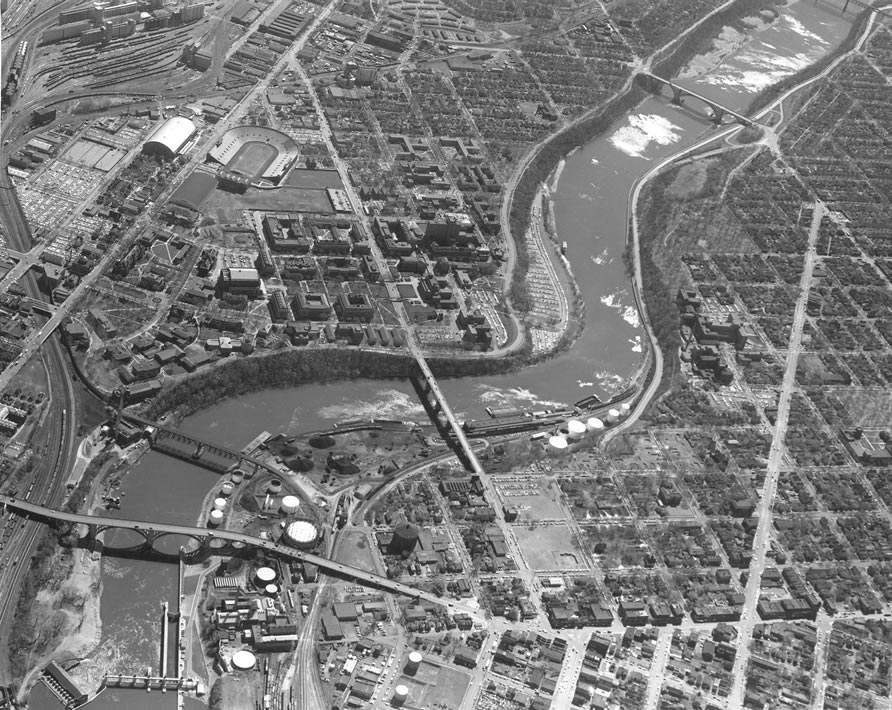
The Tenth Avenue Bridge in Minneapolis (shown in the lower portion of the 1959 photo above) was the path for a 54-inch water main from the 1940s until recently. More than 50 years later, the main was removed as the bridge went through renovations. Minneapolis Public Works Water Treatment and Distribution Services Division, rather than going back to its old way, is using an emerging technology. The 1959 photo shows the configuration and street schemes of the Seven Corners area of the West Bank prior to the 35W bridge. The Washington Avenue Bridge, replaced in the latter part of the 1960s, is downstream around the bend. The photo below, taken in September 2020, shows the rehabilitation of the Tenth Avenue Bridge. Beyond it are the 35W bridge, the lower St. Anthony Falls lock and dam, and the downtown skyline. Full story below.
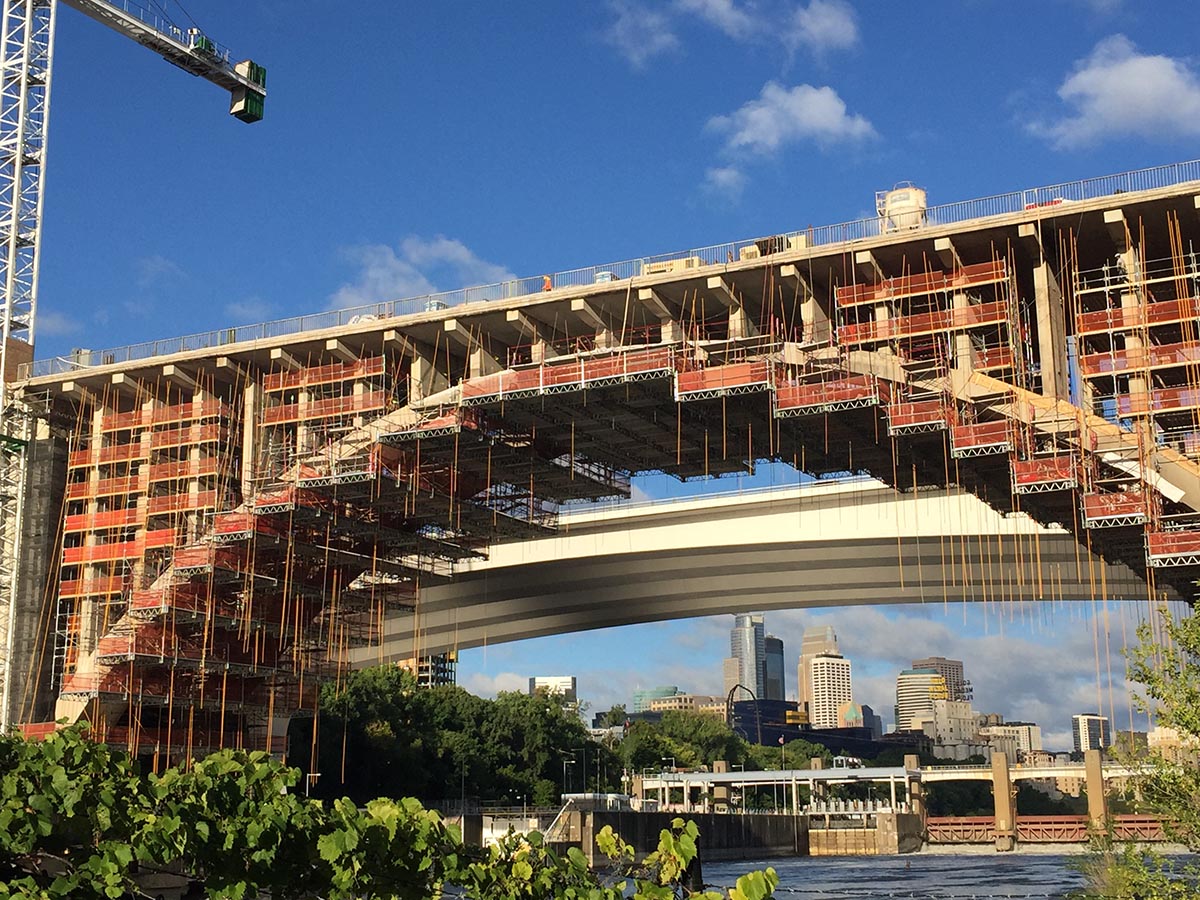
Go to top
Opt-in to be required to remain on mailing list for printed copies of Waterline
The Minnesota Department of Health Waterline newsletter will continue to be available on-line:
Readers can sign up for email notifications each time a new edition is put on the web:
Whereas many online subscribers have opted out of receiving printed copies in the mail, others have continued to receive them.
Next year, however, readers will have to opt-in to continue receiving a printed copy. Those who don’t will be dropped from the mailing list. The next Waterline should have a link to a website to sign up to continue to receive printed copies.
Readers can also opt-in by sending their mailing label (or a copy of it) from a current Waterline to Stew Thornley, MDH, P. O. Box 64975, St. Paul, Minnesota 55164-0975.
Go to topd
Department of Agriculture develops videos on groundwater and Nitrate movement in southeast Minnesota
The Minnesota Department of Agriculture has released a series of educational videos demonstrating groundwater movement through the karst geology of the southeastern part of the state. Combining animation with local science, these videos help show the direct connections between groundwater and surface water, explain why certain wells are more vulnerable to nitrate contamination, and why nitrate-nitrogen levels are slowly increasing in certain streams. Although this project focuses on different landscapes in the Root River Watershed, the information can be applied throughout southeast Minnesota and the Driftless Area of the Upper Midwest. High-resolution graphics and short, two-minute animations are also available.
“The flow of groundwater in southeast Minnesota is fascinating and complex because the unique geology is like no other area of the state,” said Agriculture Department hydrologist Kevin Kuehner. “By understanding how groundwater moves through the soil and various layers of rock, viewers can better understand how water-soluble contaminants like nitrate-nitrogen can enter drinking water wells and streams.”
Southeast Minnesota Groundwater Resources
Go to top
Minneapolis uses Microtunneling for water main below the Mississippi River
Seven of the largest water mains carrying drinking water in Minneapolis cross the Mississippi River at various locations in the city. Some of the water mains are suspended from bridges that span the waterway. Others, including two near the Minneapolis Public Works Water Treatment and Distribution Services Division (WTDS) treatment plant and river intake in Fridley, are in trenches in the riverbed.
Just downstream of downtown is a water crossing that has transitioned from a trench to a bridge and now to something new. Even before the Tenth Avenue Bridge was completed in 1929, the city had a riveted steel waterline in a shallow trench in the riverbed, connecting the area known as West Bank to southeast Minneapolis in the vicinity of the University of Minnesota.
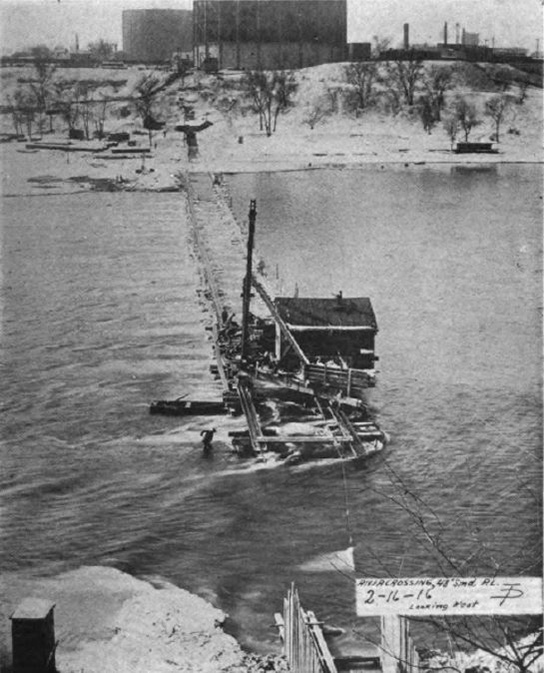 |
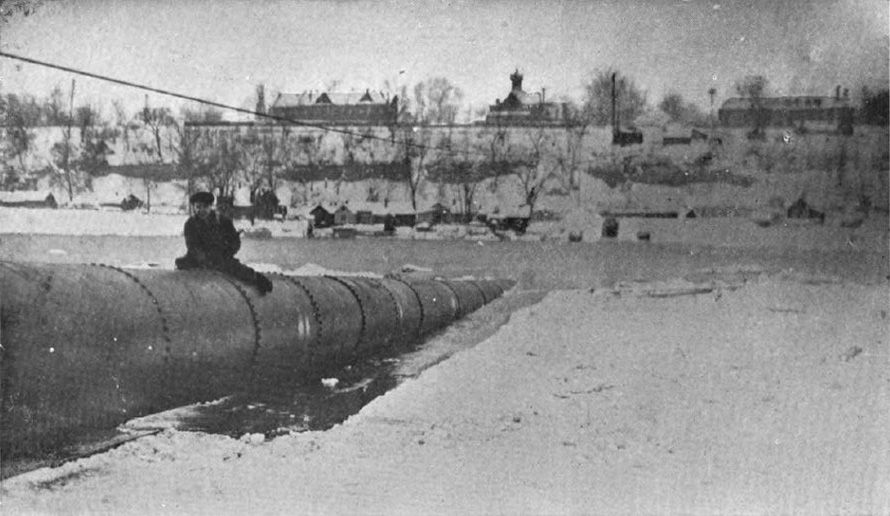 |
A photo from 1916 taken from the eastern bank of the Mississippi River (left) shows the construction of a trench for a waterline to be placed in the river bed. A 1917 photo (right), taken from the west bank of the river, shows the riveted steel pipe being submerged.
The city replaced this line with a 54-inch welded steel main above the arches in the 1940s. What prompted the change isn’t certain although it is speculated that it was because of a desire by the U. S. Army Corps of Engineers to dredge the river for a deeper channel to allow navigation farther upstream. The Upper Minneapolis Harbor Development project, which eventually included the construction of two locks and dams by St. Anthony Falls, was already underway. (In 2015, the upper lock and dam – which lifted barges and boats 50 feet to get beyond the falls – was closed to stop the spread of invasive carp.)
With a renovation planned for the Tenth Avenue Bridge two years ago, Minneapolis WTDS looked at another way of maintaining a cross-river waterline. The exposed waterline was subject to freezing if shut down, and it experienced repeated expansion and contraction from cold and heat, especially since the pipe had no expansion joints. The pipe’s exterior coating was deteriorating, and the main was corroded from runoff carrying road salts that would leak through expansion joints on the bridge.
Rather than hang another main above the river, the city decided to go back down, this time all the way below the Mississippi with a tunnel 30 feet below the riverbed employing modern microtunneling technology. Remote-controlled pipe jacking has become popular for urban construction since it is environmentally friendly and causes less disruption than traditional open trenching. It is also an ideal way to get a waterline from one side of a river to the other.
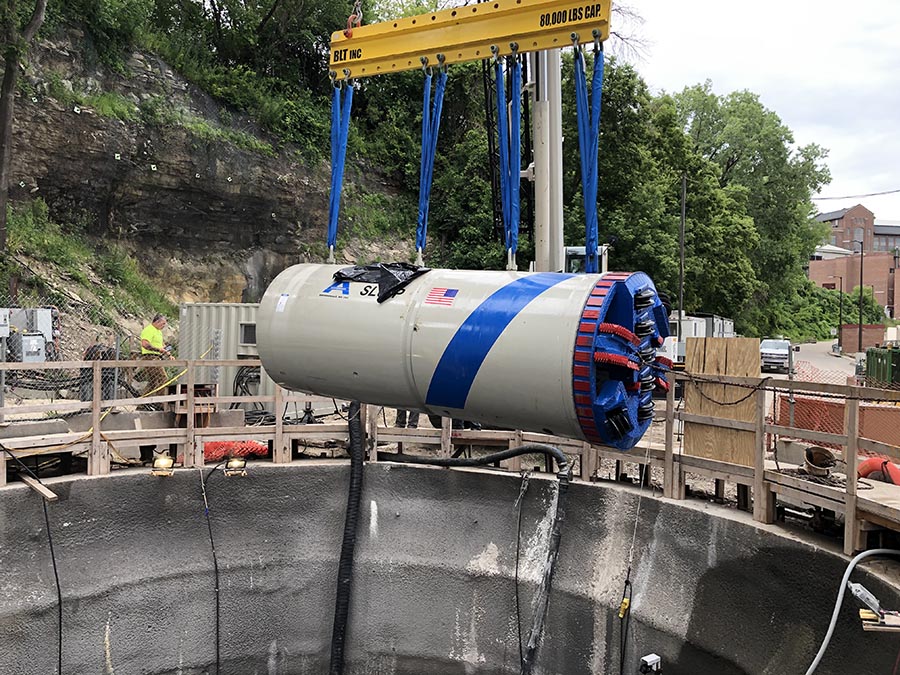
The microtunneling machine is lowered into a pit on the east bank. Driven by hydraulic jacks, the machine has cutting heads to drive through the soil and a conical crusher to grind the material into smaller particles, which are removed with a slurry and brought to a chamber on the surface. An operator in a trailer on the ground steers the machine with the help of a laser-guidance system.
“You get only a few chances to do something different,” said Glen Gerads, director of water treatment and distribution for Minneapolis Public Works.
Getting the water main out of the elements means a much longer life expectancy for the pipe. Peter Pfister, an engineer for Minneapolis WTDS and the project manager for the venture, pointed out that this also calls for a careful adherence to quality control because of the difficulty of making repairs to a pipe buried under a river.
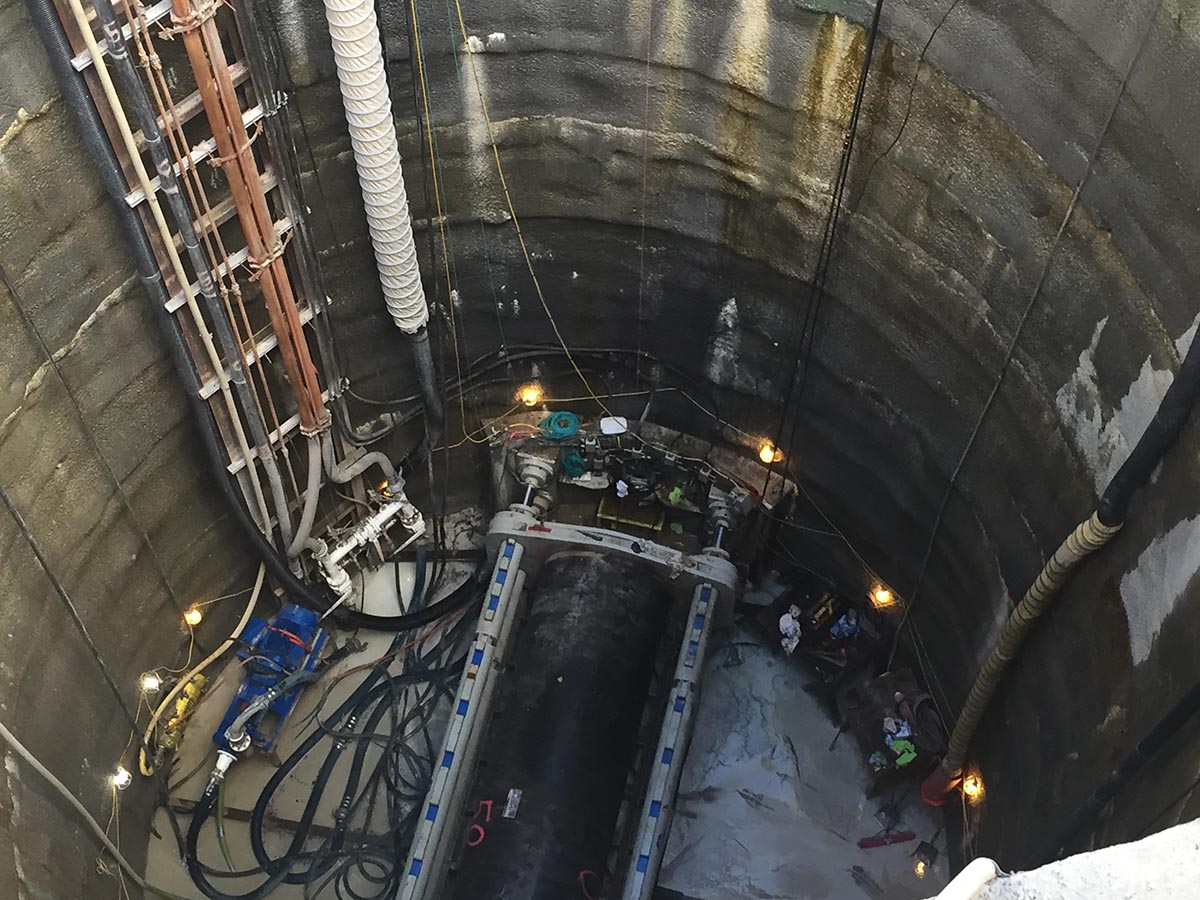
The hydraulic jacking frame in the sending pit on the east bank.
The project began in 2019 with the construction of shafts on each side of the river. The sending pit is on the east bank (actually on the north side at this bend of the river). Its excavation was facilitated by the freezing of the groundwater, which allowed the contractor to dig through frozen soil. It is approximately 900 feet from the target, the receiving pit in Bluff Street Park on the west bank (the southern side). The pits are as deep as 130 feet and large enough to fit the tunneling machine.
Lowered by a crane into the sending pit, the laser-guided microtunnel boring machine was controlled from the top of the shaft to emerge at the proper spot. As the boring progressed, a bentonite slurry was pumped from the surface to ports inside the tunneling machine to its exterior front and sides, providing cooling and lubrication for the motor. “The slurry then picks up removed soil and rock and carries it back up to the surface, where the removed material is separated from the slurry by a shaker-sieve apparatus,” explained Pfister. “The filtered slurry is then cycled back to the tunnel machine.”
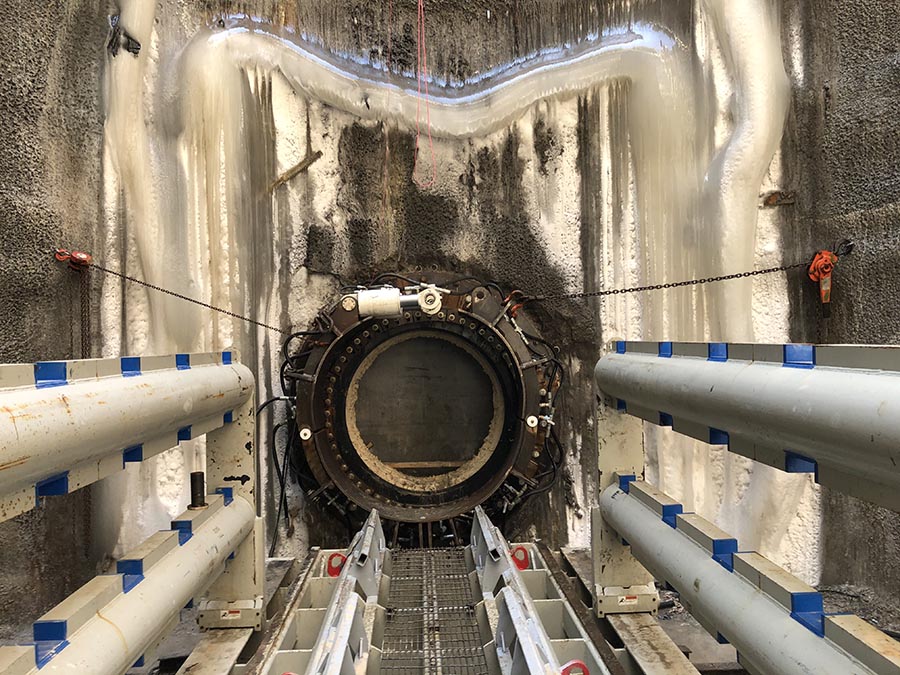 Penetration by the tunneling machine in the working shaft. The metal collar is referred to as a thimble, where a rubber static seal and a rubber inflatable seal are situated such that when the machine and casing pipe are inserted into the thimble and the inflatable seal is inflated with air, it constricts around the pipe, keeping the groundwater from coming into the shaft.
Penetration by the tunneling machine in the working shaft. The metal collar is referred to as a thimble, where a rubber static seal and a rubber inflatable seal are situated such that when the machine and casing pipe are inserted into the thimble and the inflatable seal is inflated with air, it constricts around the pipe, keeping the groundwater from coming into the shaft.
A 60-inch permalock casing pipe followed the tunneling machine, which took about two weeks to reach its destination on the west bank. Then the sections of main will be lowered into the shaft and propelled by a hydraulic jacking frame, each of them welded together. Pfister said the length of each section was only 20 feet, its length constricted by the diameter of the pit.
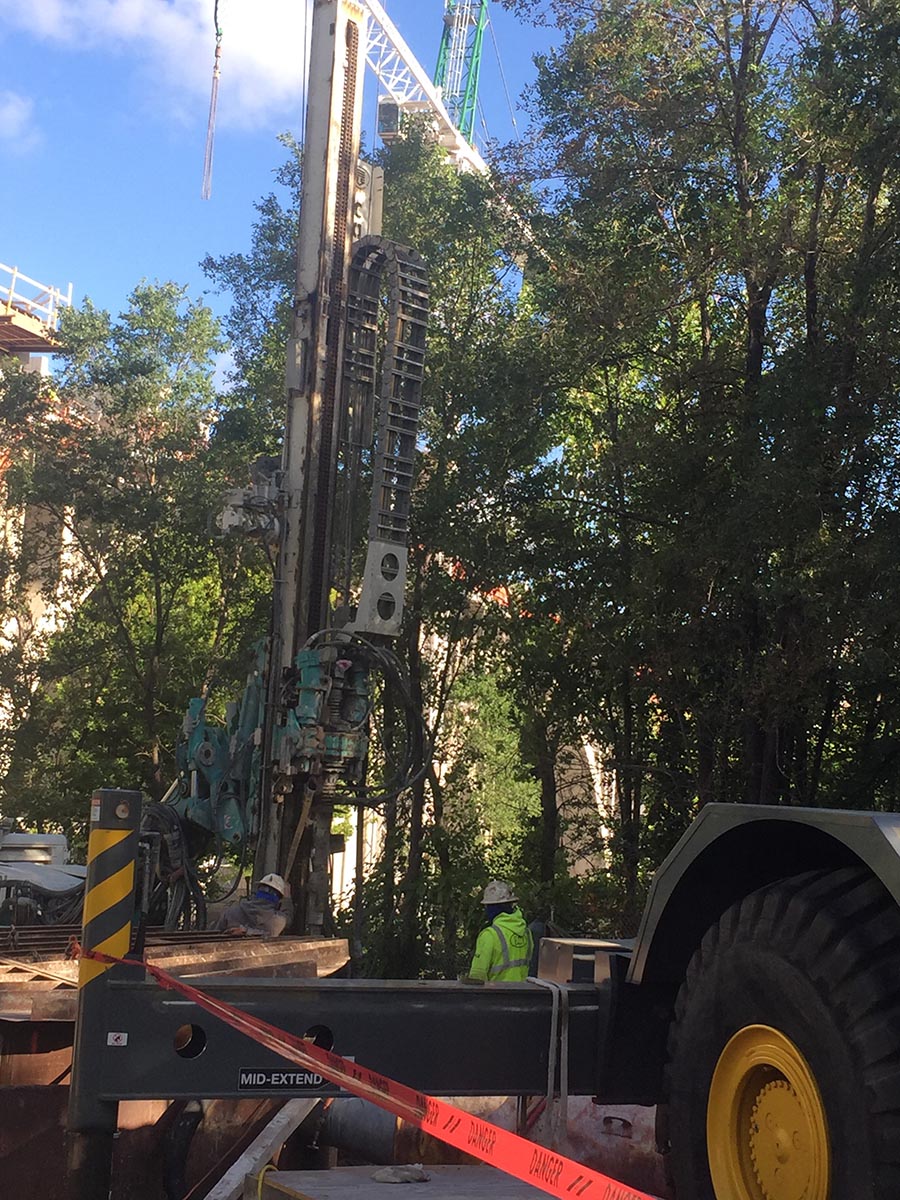
The receiving pit in Bluff Street Park on the west bank of the Mississippi River.
Gerads said that the life-cycle costs made this a more viable solution than to hang the main from the bridge again. “We’re going back to where we were, and we won’t have to worry about it for a couple hundred years.”
Work on the $16 million project progressed on schedule – even the coronavirus disease 2019 pandemic did not slow it down as the city and contractors employed precautions to keep workers safe – with expectations for the new water main to be on-line in the spring of 2021.
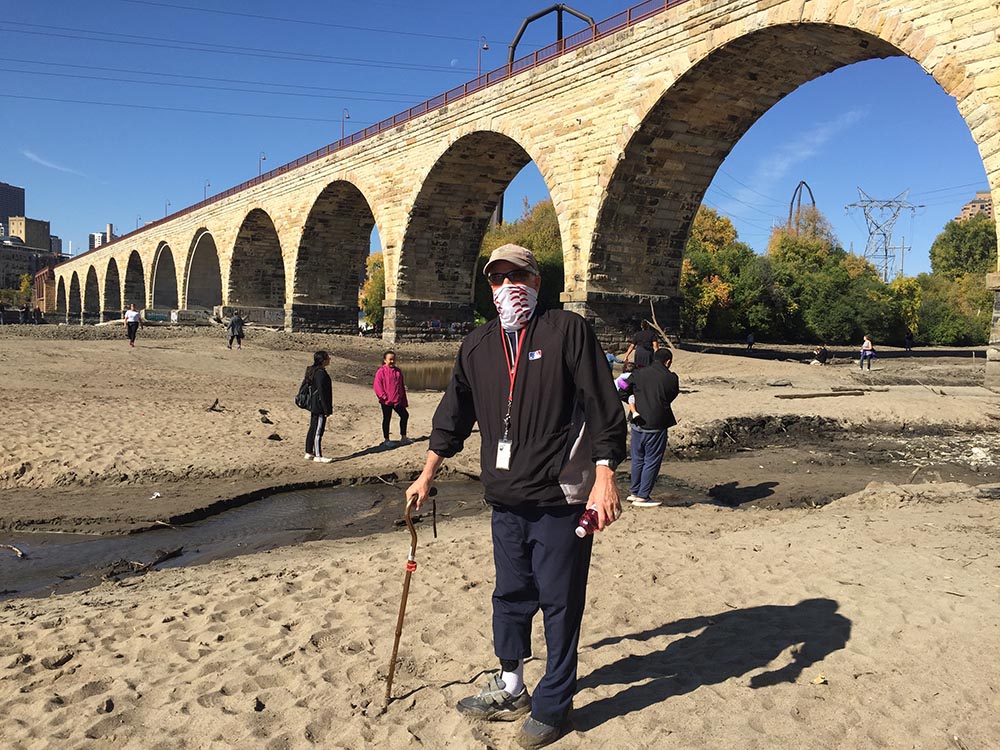
Upriver a bit from the site of the Minneapolis waterline project is a portion of the bed of the Mississippi River. This area became accessible when the U. S. Army Corps of Engineers lowered the river level by 12 feet for a few days in October 2020 in order to inspect the upper and lower dams and locks at St. Anthony Falls. The exposed river bottom is mostly on the east side of the river by the Stone Arch Bridge (above). Spectators were able to go down wooden staircases along with a bit more trekking to get to the riverbed. The shadow of the bridge looms over some of the merry wanderers (below).
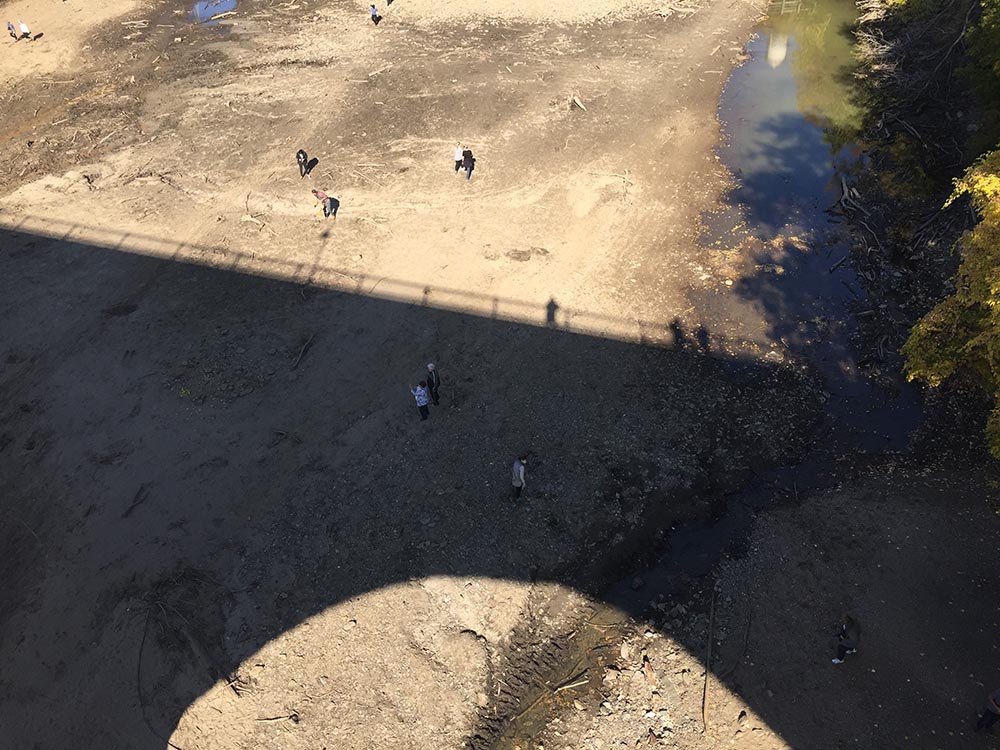
Go to top
Minneapolis scores high in customer satisfaction
Minneapolis Water Works has been ranked first in customer satisfaction for a Midwest, midsized utility. The U.S. Water Utility Residential Customer Satisfaction Study, now in its fifth year and conducted by J. D. Power, measures satisfaction among residential customers of 90 water utilities that deliver water to at least 400,000 customers and is reported in four geographic regions and two size categories: Midwest Large, Midwest Midsize, Northeast Large, Northeast Midsize, South Large, South Midsize, West Large and West Midsize. Overall satisfaction is measured by examining 33 attributes in six factors (listed in order of importance): quality and reliability, price, conservation, billing and payment, communications, and customer service.
Go to top
MDH Profile: Kate Callais
 Kate Callais is the new Minnesota Department of Health (MDH) engineer in southeastern Minnesota, succeeding Paul Halvorson, who retired. Kate came from San Antonio, where she worked for the city in transportation and capital improvements. Kate received her civil engineering degree from the University of Texas.
Kate Callais is the new Minnesota Department of Health (MDH) engineer in southeastern Minnesota, succeeding Paul Halvorson, who retired. Kate came from San Antonio, where she worked for the city in transportation and capital improvements. Kate received her civil engineering degree from the University of Texas.
Before becoming an engineer, she was a hair stylist and makeup artist for 10 years. “Most people think that the two careers couldn’t be more different,” Kate says, “but both jobs are firmly rooted in creative problem solving.” In her spare time, Kate enjoys film, painting, biking, video games, and plants.
She and her fiancé now live in Rochester with a silly Doodle named Emmy Lou and a serious cat named Luna.
Other additions to the MDH Community Public Water Supply unit include Michael Bourland as the new lead and copper engineer and Alex Martell as a compliance engineer. Alex had worked for the MDH Well Management Section and says he is “excited by the opportunity to observe filtration tanks from the top” after spending his career crawling on top of media in enclosed spaces.
Karla Peterson Receives George Warren Fuller Award
In other unit news, supervisor Karla Peterson was the recipient of the George Warren Fuller Award from the Minnesota Section of American Water Works Association. This award is given by AWWA each year to a member of the association, selected the preceding year by and from each Section, for his or her distinguished service in the water supply field and in commemoration of the sound engineering skill and the constructive leadership of a person in the Association who characterized the life of George Warren Fuller—one of America’s most eminent engineers.
Karla has worked in the Community Water Supply Unit since 1993 and has been the unit supervisor since 2007. She is a past-chair of Minnesota AWWA.
Previous recipients of the Fuller Award from the Minnesota Department of Health include Dave Schultz, Doug Mandy, and Gary Englund.
Go to top
Freeport facelift completed
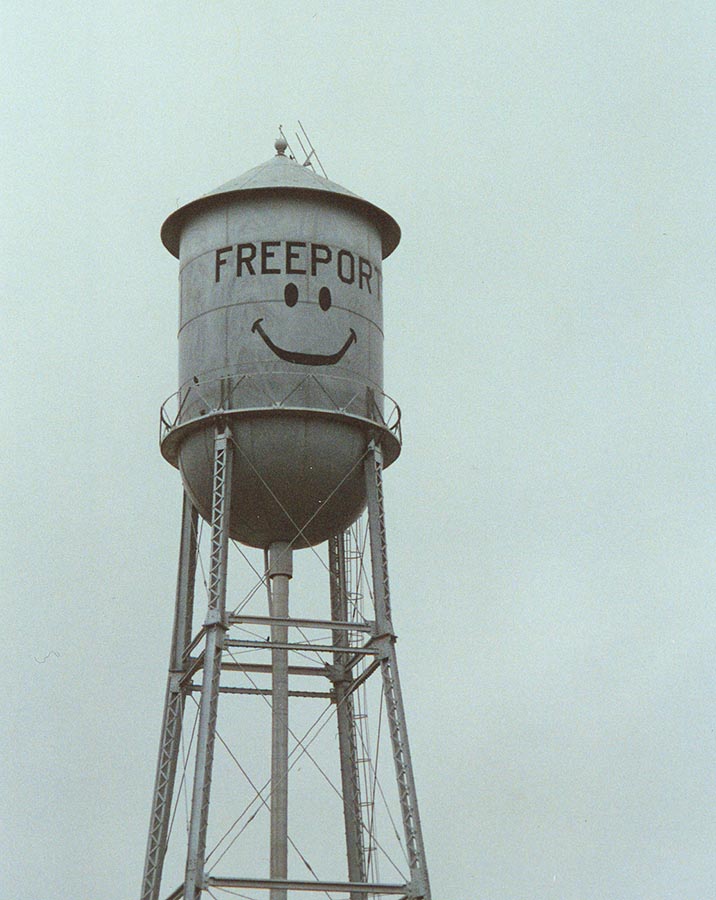 As reported in the Summer 2020 Waterline, the central-Minnesota city of Freeport has been raising money to save its smiley-face water tower. The city erected a new tower in 2003, but the old one still greets travelers on Interstate 94 as they head from the Twins Cities to Sauk Centre and points beyond. The fundraising was successful as the community raised more than $30,000, which has allowed the city to sandblast and recoat the tower and to add a newer and shinier smiley face. The tower no longer holds water, but an engineering study confirmed that it is structurally sound and needed nothing more than a facelift.
As reported in the Summer 2020 Waterline, the central-Minnesota city of Freeport has been raising money to save its smiley-face water tower. The city erected a new tower in 2003, but the old one still greets travelers on Interstate 94 as they head from the Twins Cities to Sauk Centre and points beyond. The fundraising was successful as the community raised more than $30,000, which has allowed the city to sandblast and recoat the tower and to add a newer and shinier smiley face. The tower no longer holds water, but an engineering study confirmed that it is structurally sound and needed nothing more than a facelift.
The old smiley face is at the right, the new one below. Can you spot any differences?
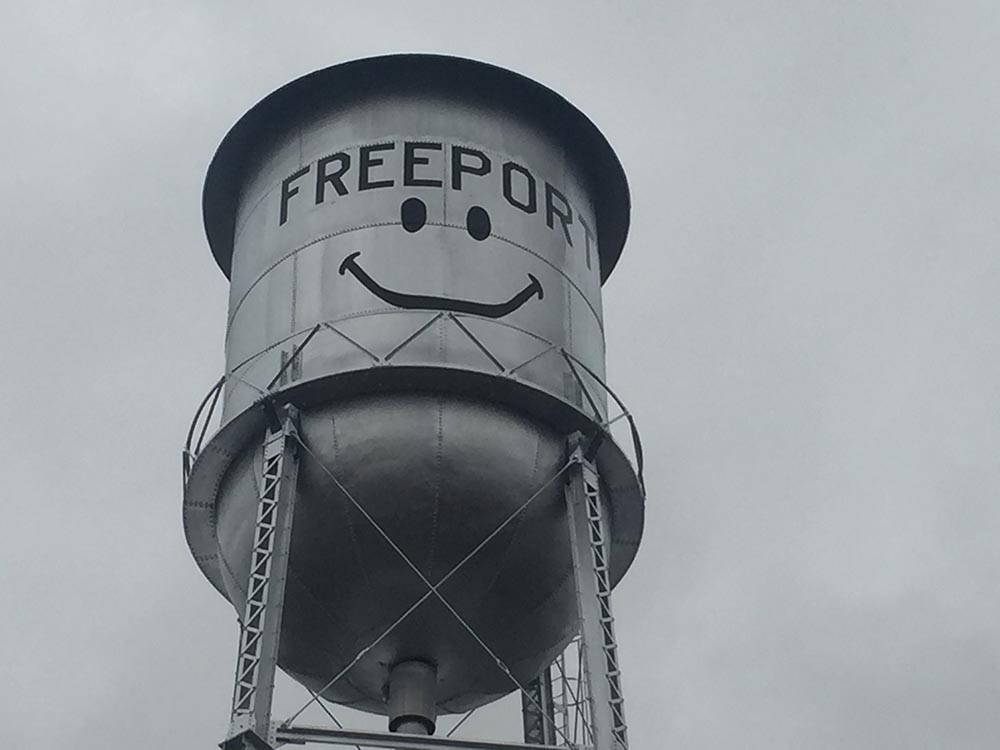
Go to top
WUTT's up next
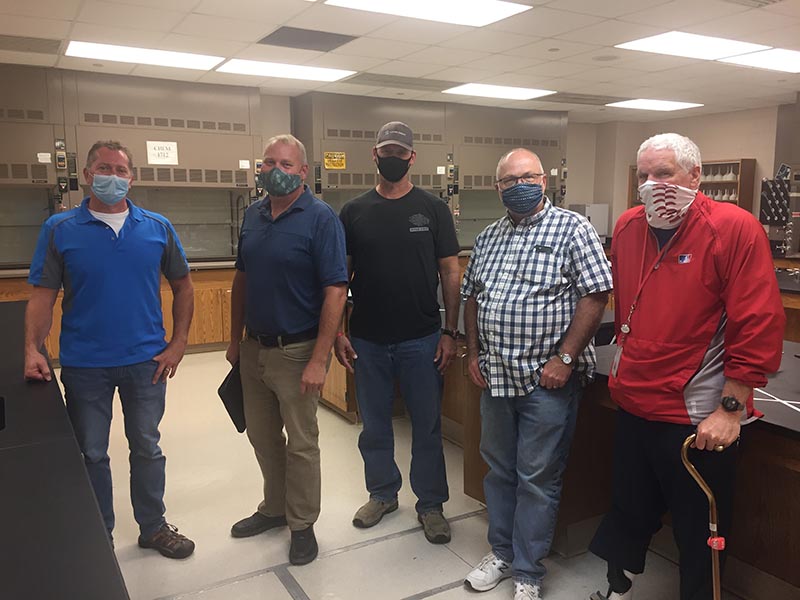
Water Utilities Treatment and Technologies (WUTT) instructors George Kraynick, Paul Christensen, and Dave Simons; curriculum developer Bill Spain; and a WUTT advisory board member gathered at St. Paul College September 21 to prepare for the first WUTT class.
WUTT was designed after the closing of a satellite water environment technologies program at the Eden Prairie Water Plant. It fills a need for recruitment and education for employees for water systems in the Twin Cities. The advisory board has developed a non-credit series of modules to be taught at St. Paul College starting in January 2021. More information: St. Paul College Continuing Education/Workforce Training
Equipment donations for classes are sought, especially lab equipment such as spectrometers, magnetic filter funnels, pH meters, and reagents. Contact Steve Grossman, sgrossman@lakevillemn.gov, for information about donating.
Go to top
Source Water Protection Grants support community solutions to protect drinking water
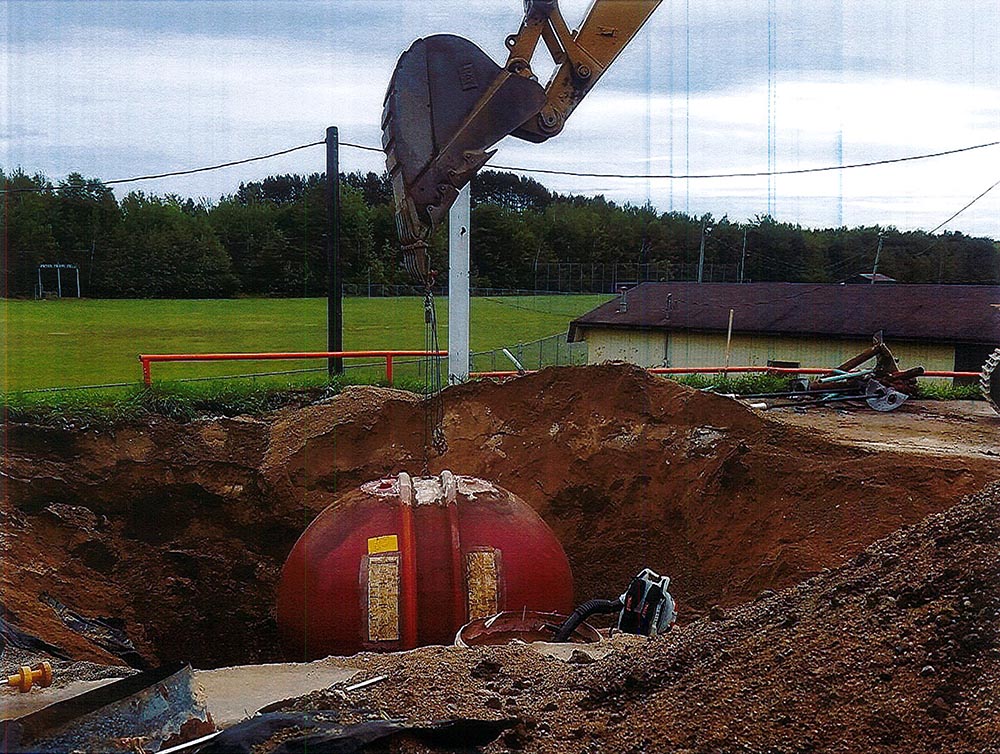
By Alycia Overbo, Minnesota Department of Health (MDH)
Source Water Protection Grants are available to public water systems to manage and eliminate potential threats to drinking water. Although these grants are relatively small, up to $10,000, they can have a big impact. Source Water Protection Grants, made possible through the Clean Water Fund, have helped many Minnesota communities protect their drinking water sources. The grants fund activities ranging from community outreach to sealing unused wells to installing rain gardens to planting cover crops. In three communities in Itasca County, these grants have been instrumental in mitigating threats to drinking water.
The Itasca County cities of Bovey, Calumet, and Keewatin each had abandoned gas stations in their Drinking Water Supply Management Area (DWSMA), the area that supplies groundwater to the public well. The communities became aware that each site had multiple underground storage tanks that were leaking and threatening their drinking water quality. The communities called upon the Minnesota Pollution Control Agency (MPCA) to investigate the tanks. MPCA conducted monitoring and site assessments for contamination and closed the projects, but the tanks remained underground.
The site owners decided to abandon the parcels because of the liability from the underground storage tanks. Itasca County became the owner of the tax-forfeited parcels. “The county didn’t know what to do with the land, the city didn’t know what to do with the underground storage tanks, and the potential liability kept prospective buyers at bay,” explained MDH planner Chris Parthun.
Parthun identified the tanks as potential sources of contamination in the cities’ Wellhead Protection Plans. He recommended that the communities apply for Source Water Protection Grants to remove the tanks. Since the tanks were identified in their Wellhead Protection Plans, each community was eligible for grant awards up to $10,000. Removing the leaking tanks would prevent them from causing contamination of the communities’ drinking water sources.
Bovey (shown with its tank removal in the photo above) was the first of the three to apply for a grant
to remove the underground storage tanks. Bovey made arrangements with Itasca County and Twin Ports Environmental/Construction (TPEC), a consulting company in Duluth. Keewatin and Calumet were able to partner on Bovey’s bid with TPEC, and Itasca County agreed to pay for any expenses that exceeded their grant awards.
Once the tanks were successfully removed, the sites were tested to ensure they were safe and restored. Itasca County transferred ownership of the parcels to the cities so they could ensure that future land use on the sites would continue to benefit source water quality. In 2020, Bovey and Calumet were recognized for their efforts as finalists for the MDH Source Water Protection Awards.
Parthun concluded, “This was an outstanding example of local cooperation made possible by the MDH grants program. The potential contaminants have been removed from each city’s DWSMA, and the parcels are now under local control.”
Applications for Source Water Protection Grants are accepted in the spring and fall of every year. For more information:
Source Water Protection Grants
Go to top
Reminder to all water operators
When submitting water samples for analyses, remember to do the following:
- Take coliform samples on the distribution system, not at the wells or entry points.
- Write the Date Collected, Time Collected, and Collector’s Name on the lab form.
- Attach the label to each bottle (do not attach labels to the lab form).
- Include laboratory request forms with submitted samples.
- Do not use a rollerball or gel pen (the ink may run).
- Consult your monitoring plan(s) prior to collecting required compliance samples.
Notify your Minnesota Department of Health district engineer of any changes to your systems.
If you have questions, call the Minnesota Department of Health contact on the back of all sample instruction forms.
Calendar
Operator training sponsored by the Minnesota Department of Health and the Minnesota AWWA will be held in several locations this spring.
Register for schools and pay on-line:
Go to top